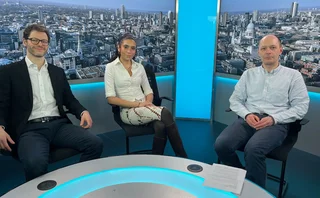
Why the US election fallout was not a surprise to banks
A contested result was unexpected, but scenario planning meant banks weren’t unprepared
There’s an anecdote in The Big Short that makes the case for stress-testing as a backstop to risk modelling more effectively than any regulatory dictum could.
Michael Lewis is documenting Morgan Stanley’s massive bets on subprime mortgage bonds in the run-up to the US housing market collapse of 2007, which, after lucrative early successes, were being run out of a specially formed unit led by bond trader Howie Hubler.
Hubler’s positions in collateralised debt obligations were stress-tested for scenarios in which losses on subprime pools reached 6% – the highest in recent history – and still showed a healthy profit. Morgan Stanley’s then-chief risk officer, Tom Daula, asked what would happen if losses hit 10%. Lewis documented the reaction of Hubler and his traders:
“It was more than a little weird,” says one of them. “There was a lot of angst about it. It was sort of viewed as: ‘These folks don’t know what they’re talking about. If losses go to 10%, there will be, like, a million homeless people.’” (Losses in the pools Hubler’s group had bet on would eventually reach 40%.) As a senior Morgan Stanley executive outside Hubler’s group put it: “They didn’t want to show you the results. They kept saying: ‘That state of the world can’t happen.’”
Fast-forward to today, and traders seem more willing to ask ‘what if’.
As Lewis’s bemused exec had it, plenty of people had thought the current state of the world – a contested US presidential election in the middle of a pandemic that has killed millions and wrecked the global economy – couldn’t happen, either. Traders could be forgiven for dismissing a scenario in which the election result looks set to remain unclear for days, if not weeks, which the incumbent has claimed his opponent is trying to rig, and called for millions of votes not to be counted.
Many did hypothesise such a situation – which might go some way to explaining why market reaction has been muted to the point of being “eerily quiet”, as one trader has it
But, clearly, many did hypothesise such a situation – which might go some way to explaining why market reaction in the immediate aftermath has been muted to the point of being “eerily quiet”, as one trader has it.
“This scenario was not out of the realm of possibilities. People were considering it, and would have priced something that looked like this,” says a senior risk manager at a US bank.
“They might’ve assigned a lower probability to it, but it’s not taking them by complete surprise.”
At its crudest, stress-testing forces firms to look at their risk drivers, scratch their heads, and talk to their traders and portfolio managers about whether they’d still be comfortable with their exposures if a given situation came to pass.
As the risk manager sees it: “After 2016, people learned not to take the most obvious outcome as a given, and to plan for chaos. Every firm should have planned and strategised around these outcomes. Banks will have a playbook they can follow for what’s likely beyond this point.”
Of course, like any risk measure, stress tests can be gamed – and, as in the unfortunate case of Morgan Stanley’s credit teams, their outputs ignored. But even if a given outcome is unexpected, banks shouldn’t be unprepared.
Only users who have a paid subscription or are part of a corporate subscription are able to print or copy content.
To access these options, along with all other subscription benefits, please contact info@risk.net or view our subscription options here: http://subscriptions.risk.net/subscribe
You are currently unable to print this content. Please contact info@risk.net to find out more.
You are currently unable to copy this content. Please contact info@risk.net to find out more.
Copyright Infopro Digital Limited. All rights reserved.
As outlined in our terms and conditions, https://www.infopro-digital.com/terms-and-conditions/subscriptions/ (point 2.4), printing is limited to a single copy.
If you would like to purchase additional rights please email info@risk.net
Copyright Infopro Digital Limited. All rights reserved.
You may share this content using our article tools. As outlined in our terms and conditions, https://www.infopro-digital.com/terms-and-conditions/subscriptions/ (clause 2.4), an Authorised User may only make one copy of the materials for their own personal use. You must also comply with the restrictions in clause 2.5.
If you would like to purchase additional rights please email info@risk.net
More on Our take
Podcast: Lyudmil Zyapkov on the relativity of volatility
BofA quant’s new volatility model combines gamma processes and fractional Brownian motion
Market knee-jerks keep VAR models on their toes
With a return to volatility, increased backtesting exceptions show banks’ algos are stretched
A market-making model for an options portfolio
Vladimir Lucic and Alex Tse fill a glaring gap in European-style derivatives modelling
How AI agents could become investing’s crash test dummies
Firms mull the use of chatbot simulations to test organisational set-ups
Degree of influence 2024: volatility and credit risk keep quants alert
Quantum-based models and machine learning also contributed to Cutting Edge’s output
Podcast: Alexandre Antonov turns down the noise in Markowitz
Adia quant explains how to apply hierarchical risk parity to a minimum-variance portfolio
Why did UK keep the pension fund clearing exemption?
Liquidity concerns, desire for higher returns and clearing capacity all possible reasons for going its own way
UBS’s Iabichino holds a mirror to bank funding risks
Framing funding management as an optimal control problem affords an alternative to proxy hedging








